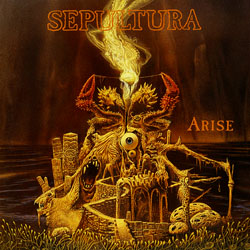Arise
1991 original CD release

1997 remastered version

Dead Embryonic Cells
1991 original CD release

1997 remastered version

Murder
1991 original CD release

1997 remastered version

Subtraction
1991 original CD release

1997 remastered version

Altered State
1991 original CD release

1997 remastered version

Under Siege (Regnum Irae)
1991 original CD release

1997 remastered version

Meaningless Movements
1991 original CD release

1997 remastered version

Infected Voice
1991 original CD release

1997 remastered version

And the winner is: 1991 original CD release. This kind of music is pretty dense, and this album is no exception. Despite the obvious limiting employed on the remaster, the apparent sonic damage to the audio is arguably not going to be as pronounced as it would be for a genre which "breathes" a bit more in its playing and arrangements and which is typically recorded with more "space" in the mix. This kind of music, however, is made to be played LOUD, and when played at a higher volume the sonic difference between the original disc and the remaster becomes clearer. The high end does suffer, most noticeably (as usual) in the drums, and there is undeniable clipping present on album closer "Infected Voice" in particular. So in this case I'm going to go with the original. Of course, one could argue that at really high volume levels the presence of too much high end can actually be unpleasantly shrill, or that the lack of some of the higher end frequencies won't be an issue since the point is to feel the music, or even (somewhat facetiously) that most hardcore metal fans are probably half deaf from too many loud concerts and wouldn't hear much of the high end anyway. If you're not an audiophile, I suppose the remaster is fine. It still sounds pretty good and the compression utilized is light years away from the stupefyingly crushed walls of sound coming out of the metal industry today. The difference between 1997 and today is akin to comparing the force of a feather to that of a sledgehammer - there's still plenty of life in the VU meter on this one regardless of which of the two releases you're looking at. The 1997 disc includes four bonus tracks in addition to the original nine. One, "Orgasmatron," originally appeared on the European edition of the album and also on the "Dead Embryonic Cells" single, which I own on cassette.
















